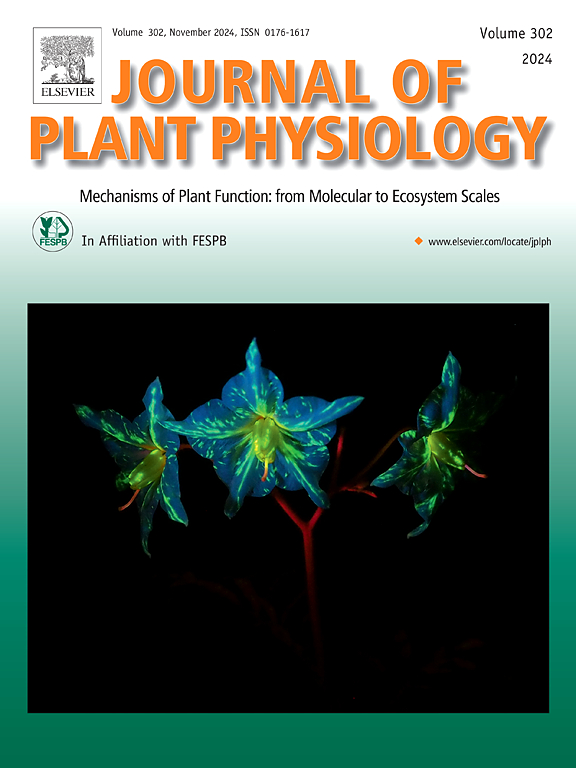Methylobacterium oryzae as a growth biostimulant of Arabidopsis thaliana and Solanum lycopersicum
IF 4.1
3区 生物学
Q1 PLANT SCIENCES
引用次数: 0
Abstract
Methylobacterium spp. bacteria occur commonly in the environment. The presence of some methylobacteria in the soil/plant have positive effect to the plants growth and can reduce or prevent the consequence of phytopathogens. We determined the effect of M. oryzae CBMB20 (rice endosymbiont) on different stages of Arabidopsis thaliana and Solanum lycopersicum development. Protective properties against phytopathogenic bacteria of M. oryzae CBMB20 lipopolysaccharide were also determined. High resolution mass spectrometry was used to confirm presence of IAA in tomato extracts. Based on the obtained results we concluded that, M. oryzae CBMB20 had no significant effect on the germination percentage of both plants but increased the number of root hairs in A. thaliana and the length of S. lycopersicum sprouts and led to an increase in the fresh weight of the plants. LPS CBMB20 was able to strengthen a defence reaction in response to the presence of the phytopathogen. S. lycopersicum, treated with CBMB20, produced more IAA than plants that were not treated with the methylobacteria, which translates into an increase in fresh mass. These findings suggest that M. oryzae CBMB20 has potential as a component of biopreparations.
拟南芥和番茄的生长促生长剂米化甲基杆菌
甲基杆菌属细菌常见于环境中。一些甲基细菌在土壤/植物中的存在对植物生长有积极的作用,可以减少或预防植物病原体的危害。研究了水稻内共生菌M. oryzae CBMB20对拟南芥和番茄不同发育阶段的影响。测定了米霉菌CBMB20脂多糖对植物病原菌的保护作用。采用高分辨质谱法确定了番茄提取物中IAA的存在。综上所述,M. oryzae CBMB20对两种植物的发芽率没有显著影响,但能增加拟南芥的根毛数和番茄芽的长度,增加植株的鲜重。LPS CBMB20能够加强对植物病原体存在的防御反应。经CBMB20处理的番茄葡萄比未经甲基菌处理的植株产生更多的IAA,这意味着鲜质量的增加。这些发现表明m.o ryzae CBMB20具有作为生物修复组分的潜力。
本文章由计算机程序翻译,如有差异,请以英文原文为准。
求助全文
约1分钟内获得全文
求助全文
来源期刊

Journal of plant physiology
生物-植物科学
CiteScore
7.20
自引率
4.70%
发文量
196
审稿时长
32 days
期刊介绍:
The Journal of Plant Physiology is a broad-spectrum journal that welcomes high-quality submissions in all major areas of plant physiology, including plant biochemistry, functional biotechnology, computational and synthetic plant biology, growth and development, photosynthesis and respiration, transport and translocation, plant-microbe interactions, biotic and abiotic stress. Studies are welcome at all levels of integration ranging from molecules and cells to organisms and their environments and are expected to use state-of-the-art methodologies. Pure gene expression studies are not within the focus of our journal. To be considered for publication, papers must significantly contribute to the mechanistic understanding of physiological processes, and not be merely descriptive, or confirmatory of previous results. We encourage the submission of papers that explore the physiology of non-model as well as accepted model species and those that bridge basic and applied research. For instance, studies on agricultural plants that show new physiological mechanisms to improve agricultural efficiency are welcome. Studies performed under uncontrolled situations (e.g. field conditions) not providing mechanistic insight will not be considered for publication.
The Journal of Plant Physiology publishes several types of articles: Original Research Articles, Reviews, Perspectives Articles, and Short Communications. Reviews and Perspectives will be solicited by the Editors; unsolicited reviews are also welcome but only from authors with a strong track record in the field of the review. Original research papers comprise the majority of published contributions.
 求助内容:
求助内容: 应助结果提醒方式:
应助结果提醒方式:


